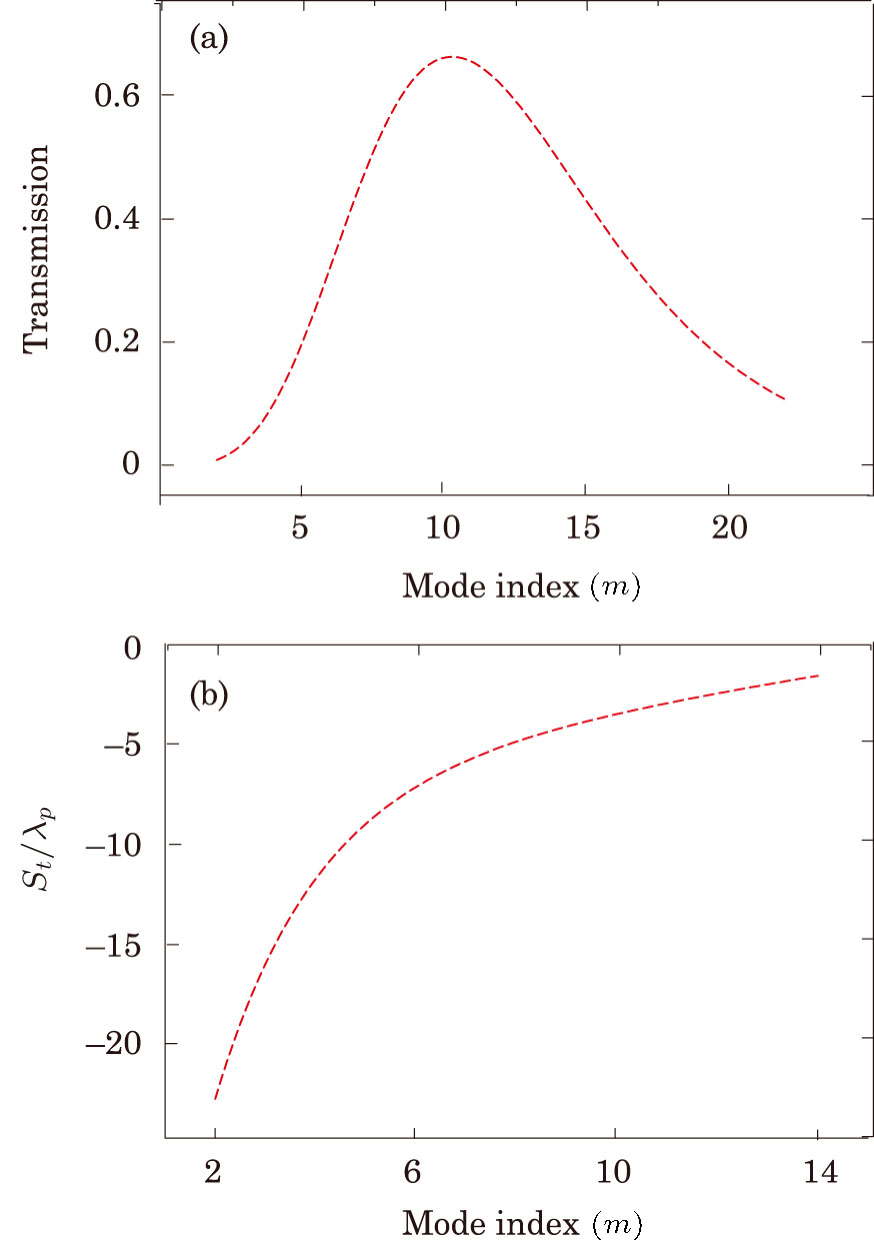† Corresponding author. E-mail:
A cold atomic medium (Rydberg medium) with cascade configuration under the blockade mechanism is considered. A partial coherent light (PCL) beam is incident on the medium, which makes an angle θ with z-axis. We study the influence of PCL field on the transmission spectrum and find high transmission of probe field for PCL field. Conversely, it is investigated that the transparency of probe field decrease for coherent light field. The transmission of probe field is also studied via beam width of PCL field and investigated high transmission of probe field for small beam width and vice versa. Interestingly, the Goos-Hänchen shift (GHS) in the transmitted light (TL) is studied for PCL field. Large negative and positive GHS in the TL are investigated for PCL field and small beam width of PCL field.
A state which has a high principle quantum number is known as Rydberg state.[1] The most important characteristic of Rydberg atom is the strong interaction of one Rydberg atom to the other. For such a strong interaction, only one excited Rydberg atom can suppress the other excitation of Rydberg atoms in a small volume, which is known as dipole blockade.[2] To address electromagnetically induced transparency (EIT) in atomic system, the Rydberg states have exhibited important characteristics such as strong dipole-dipole interactions, long radiative life time as well as the van der waals (vdW) interactions.[3] The characteristics of highly Rydberg excitations have significant role in information processing as well as in quantum gates,[4–6] many body effects,[7–9] and light atom quantum interface.[10–12]
In the above investigations, major part is dependent on the dipole blockade phenomenon.[13–14] In earlier studies, it has been revealed that the blockade phenomenon of Rydberg atom becomes a good candidate for devices like single photon sources, single photon switches, and photon filters.[15–17] Earlier, an experiment has been done in which a strong vdW interaction has been considered in atomic Rydberg medium.[18] In the experiment, a reduction in the transmission spectrum has been observed via increasing the intensity of input probe field. The authors of this experiment have no clear evidence of the reduction of transmission spectrum via increasing the probe field intensity. Later, this erratic reduction of the transmission spectrum via increasing the probe field intensity has been explained by considering a theoretical model based on the blockade phenomenon.[19] Further, the transmission of probe field has been studied in optomechanical systems.[20–21] and investigated enhanced generation of higher-order side bands.
In addition, the Goos-Hänchen shift (GHS) is a process when a light experiences a tiny displacement (shift) in the phenomenon of total internal reflection. This tiny shift has been observed by Goos and Hänchen[22] in total internal reflection in the interface of two media. After the observation of Goos and Hänchen, the GHS has been studied in different structure.[23–30] The GHS has been emerged substantial interests due to its potential applications in optical sensing such as measurement of the refractive index, beam angle, irregularities and roughness of the surface of a medium.[28] In last couples of years, the GHS has been investigated by considering atomic media and quantum well systems in a cavity.[31–38]
We consider an atomic medium consists of three-level Rydberg atoms and study the effect of PCL field on the transmission spectrum. The motivation comes from earlier investigations[18–19] where a coherent light has been used and studied the transmission of probe field through Rydberg atomic medium. In some other investigations,[39–41] the GHS and diffraction grating have been studied using PCL field. In the present work, we expect high transmission of probe field for PCL while low transmission for coherent light. Similarly, we also expect giant GHS in the TL for PCL field.
We consider a light beam 









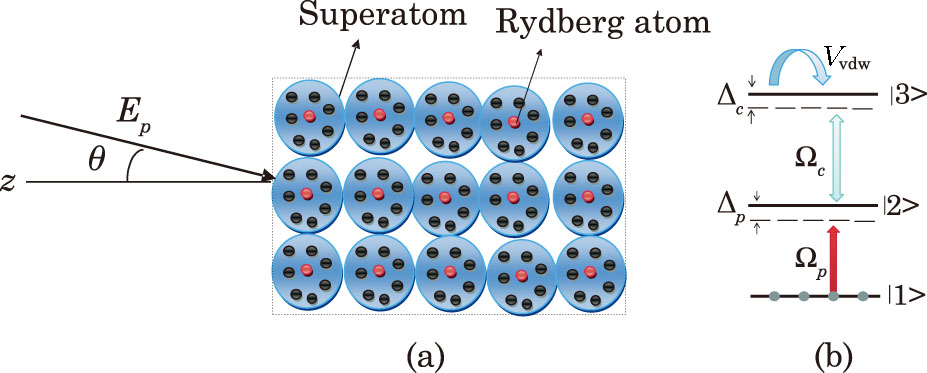 | Fig. 1. (Color online) (a) Schematics of PCL beam incident on a medium; (b) the energy-level configuration of a three-level Rydberg atom. |
We consider an atomic medium where each atom consists of cold rubidium (87Rb) atoms in a cascade configuration. The medium is interacting with probe and control fields as shown in Fig. 











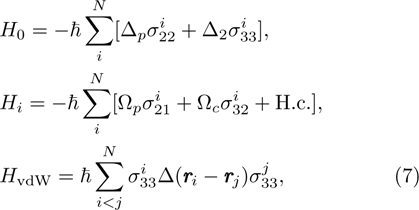































To find the expression for 

















Earlier, EIT has been realized in Rydberg atomic medium experimentally.[18,42–44] In an experiment,[18] the transmission spectrum of probe field has been studied in a medium having Rydberg states. It has been observed that the transmission spectrum of probe field decreases with increasing the intensity of the probe field and vice versa. In the experiment,[18] the authors have no clear evidence about the reduction of transmission of probe field via increasing the intensity of the probe field. Later, a theoretical model[19] has been developed and explained the reduction of probe field via increasing the intensity of probe field. The theoretical model was based on the blockade mechanism where each blockade has only one Rydberg excitation. In these investigations,[18–19] a coherent light beam has been used and investigated the transmission spectrum of probe light field. In the following, we use the same atomic medium as used earlier[18–19] and try to investigate the transmission spectrum and GHS in the transmission probe field using PCL field.
In order to study the effect of PCL field on the transmission spectrum and GHS in the transmitted probe light field, first we discuss about the role of factor q. Here, q plays an important character because for a coherent source of light 


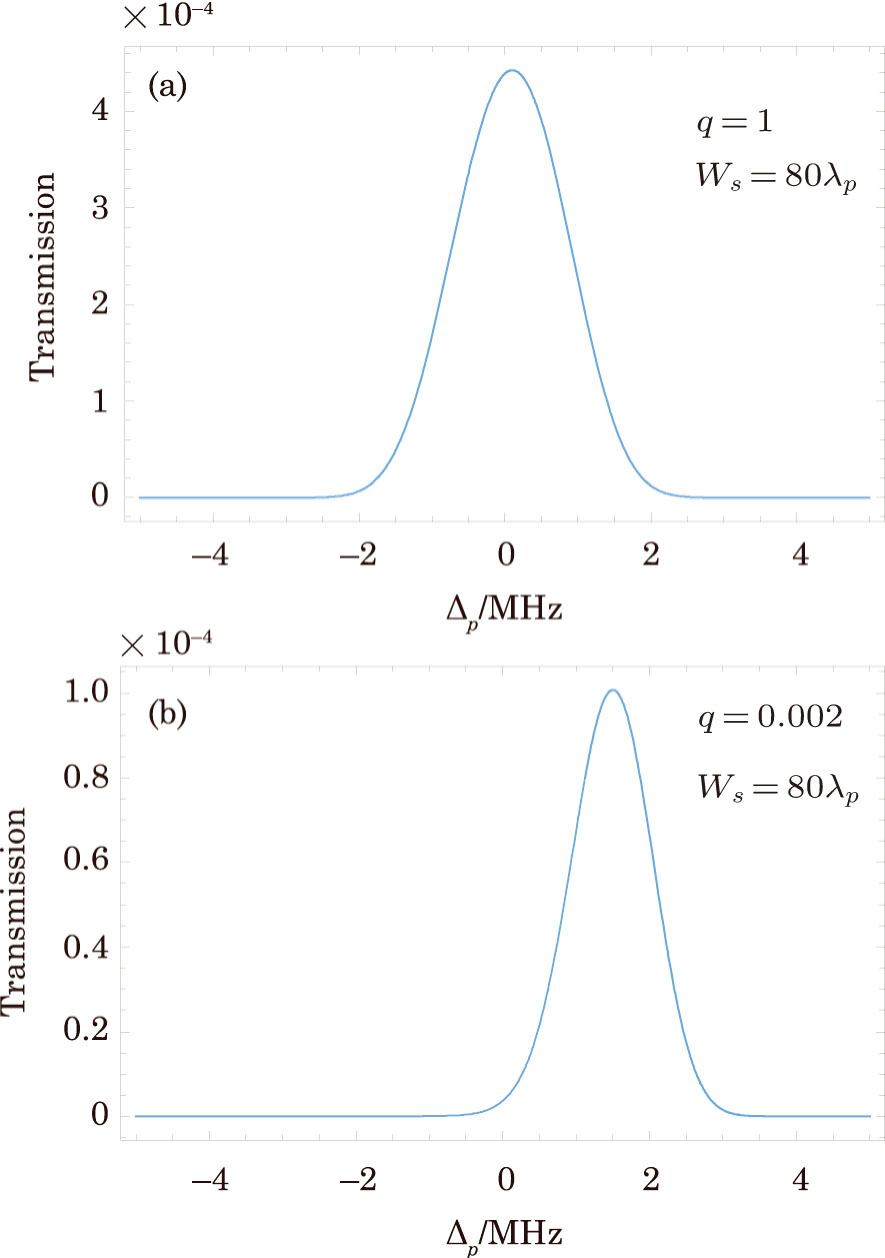 | Fig. 2. (Color online) The transmission 






|
The beam width of PCL also plays an important role when a probe field is propagating through a medium.[39–41] In these investigations,[39–41] large magnitude of the GHS and intensity of diffraction grating have been revealed for small beam width and vice versa. Therefore, here we are interested to investigate the influence of beam width on the transparency peak of probe light field. We choose the spatial coherence q=0.002 and investigate the transmission spectrum for different values of beam width of PCL. We plot the transmission of probe field versus probe field detuning as shown in Fig. 

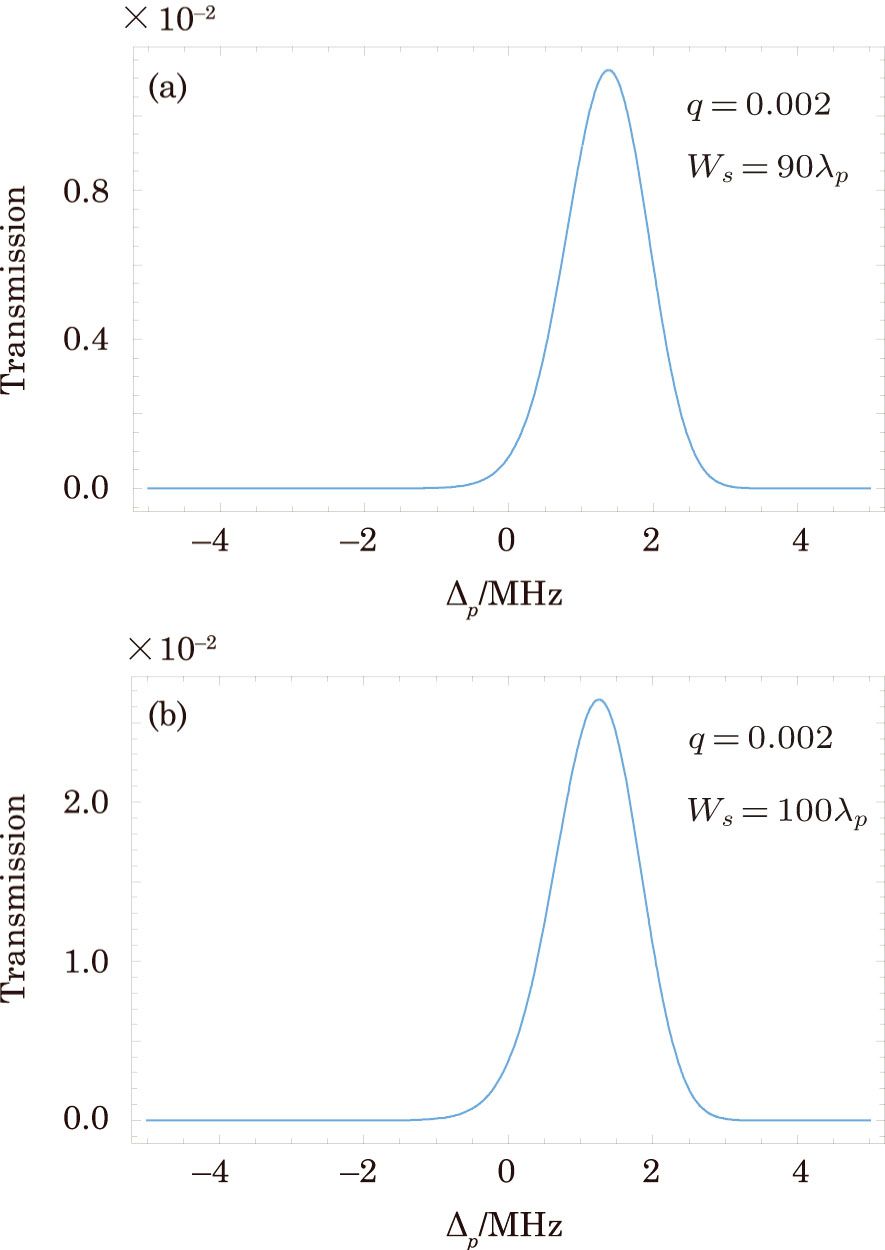 | Fig. 3. (Color online) The transmission 

|
Besides, the transmission spectrum of probe field, next we study the influence of PCL field on the GHS in the TL. We use Eq. (


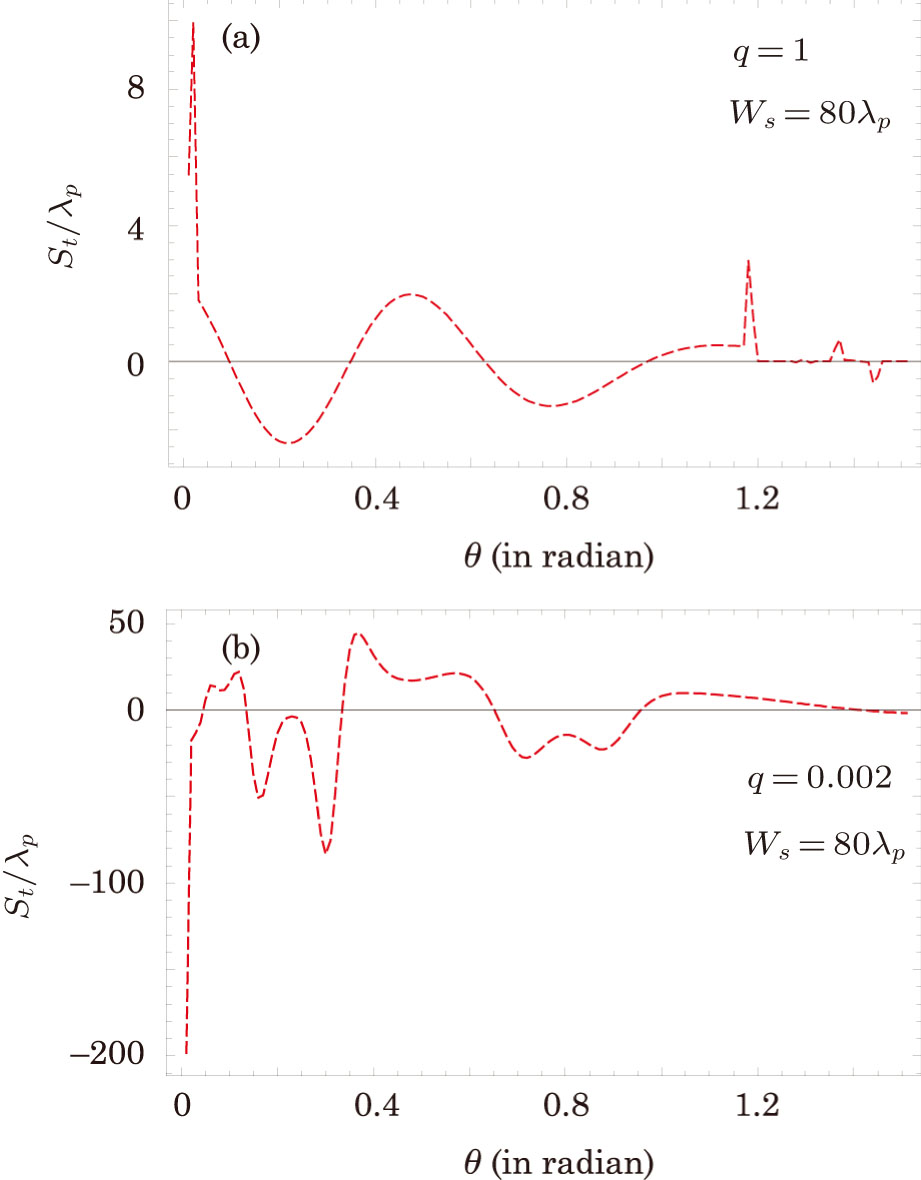 | Fig. 4. (Color online) The GHS 

|
To study the influence of beam width of PCL on the GHS in the TL, we choose the spatial coherence q=0.002 and vary the beam width. In the previous section, we investigated giant negative and positive shifts in the TL by considering 


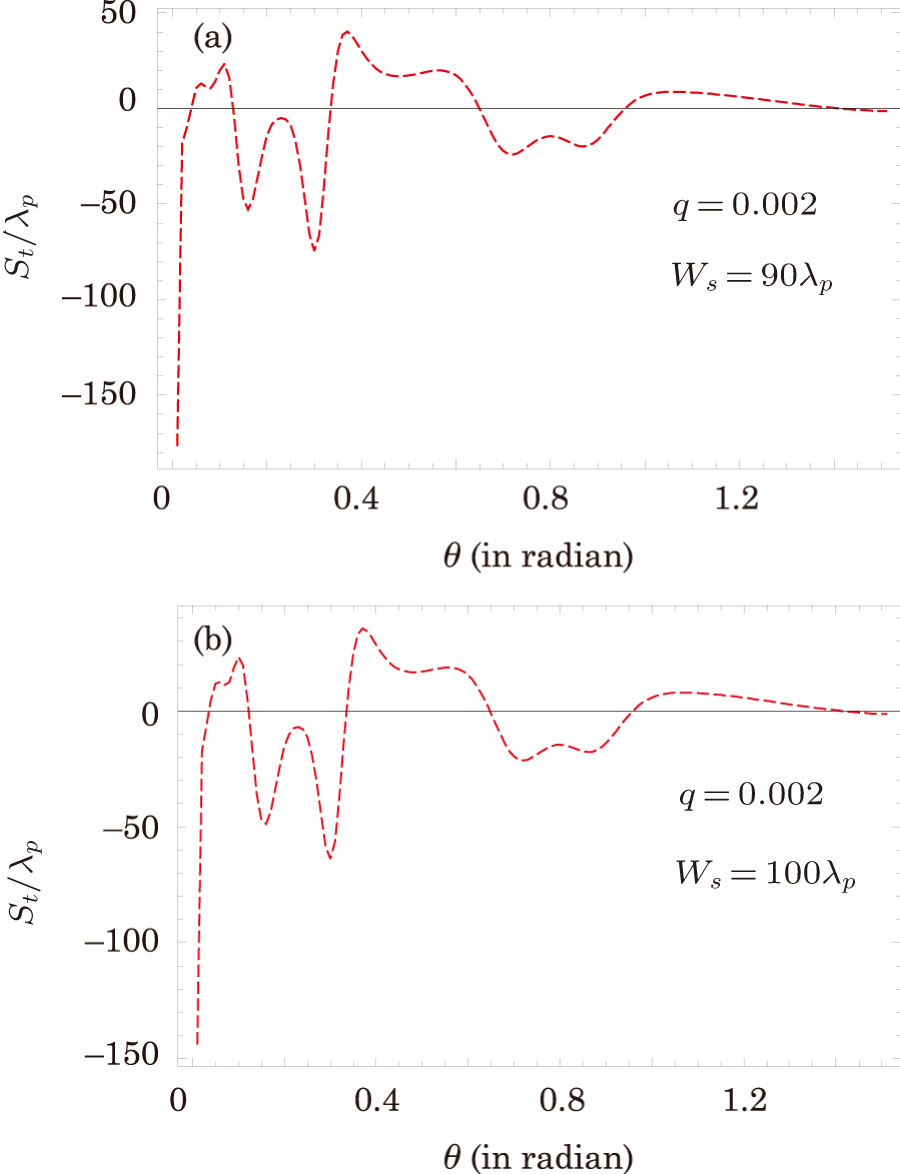 | Fig. 5. (Color online) The GHS 

|
The influence of different modes on the GHS has been studied earlier,[36] in the following we study the effect of different modes of PCL on the transmission spectrum and magnitude of the GHS in the transmitted light. For incident angle θ=0 and q=0.002, we plot the transmission of probe field versus mode index m as depicted in Fig.
In summary, we considered a cold atomic medium of cascade configuration having Rydberg excitation. A PCL beam is incident on a medium having length L and making an angle θ with z-axis. We studied the transmission of probe field and GHS in the TL under the influence of spatial coherence and beam width of PCL field. Maximum transmission of probe field is achieved for PCL field while low transmission for coherent light. Similarly, giant GHS in the TL is revealed for PCL field while investigated GHS with small magnitude for coherent light. The influence of beam width of PCL on the transmission spectrum and GHS in the TL is also studied. Maximum transmission of probe field and giant GHS in the TL are investigated for small beam width of PCL and vice versa.
| [1] | |
| [2] | |
| [3] | |
| [4] | |
| [5] | |
| [6] | |
| [7] | |
| [8] | |
| [9] | |
| [10] | |
| [11] | |
| [12] | |
| [13] | |
| [14] | |
| [15] | |
| [16] | |
| [17] | |
| [18] | |
| [19] | |
| [20] | |
| [21] | |
| [22] | |
| [23] | |
| [24] | |
| [25] | |
| [26] | |
| [27] | |
| [28] | |
| [29] | |
| [30] | |
| [31] | |
| [32] | |
| [33] | |
| [34] | |
| [35] | |
| [36] | |
| [37] | |
| [38] | |
| [39] | |
| [40] | |
| [41] | |
| [42] | |
| [43] | |
| [44] |


